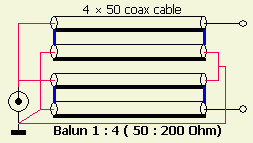|
Indoor 1 : 4 balun (33 ÁH)
Turns ratio. |
|
COAX BALUN 1 : 4, CONSTRUCTION AND USE
|
Indoor 1 : 4 balun (33 ÁH)
Turns ratio. |
|
BALUN 1 ¸ 4

An air wound balun made with coaxial cable can not saturate because no powdered iron or
ferrite core is used. The system consists of two equal lengths of coaxial cable (fig╗). On the one side in parallel and on the other side in series. If one use 50 Ω or 75 Ω coaxial cable the transformation ratio is respective 25 Ω : 100 Ω and 37.5 Ω: 150 Ω.If you want a precise 50 Ω : 100 Ω ratio, then two pieces of 100 Ω coaxial cable are required.

Eventually you may take four equal lengths of 50 Ω and then connect two to two in parallel and so that two pairs of 100 Ω (fig ╗) arise. Then the pairs are connected in parallel at the start and in series at the end.
Incidentally, a transfer ratio of 1 ¸ 4 only exist if there is a real resistive impedance (no + j or-j) of the correct value is provided.
Balancing for different complex impedance remains good, but it is even possible that a down transformation instead of an up transformation occurs.
This balun is only suitable only for an asymmetric balanced tuner with a symmetric load such as an dipole or anopen line to an antenna.See the example:


FD4
A simple but still effective way of feeding an FD4 is a single 1 ¸ 4 balun and an ATU. Most often the SWR then is less than 2 ¸ 1, which an ATU in or near the transceiver can handle without appreciable losses. That avoids the somewhat difficult task of making a 1 ¸ 6 or 1 ¸ 7 transformer. On the lower bands, a 1 ¸ 4 balun provides a lower SWR than a 1 ¸ 6 or 1 ¸ 7 transformation.
In this case
75 Ω coaxial cable may be used.CAROLINA WINDOM

Some Windom-derived antennas enhance feeder radiation on purpose. One example is the Carolina Windom (USA) which provides both, horizontally and vertically polarised radiation.
![]()